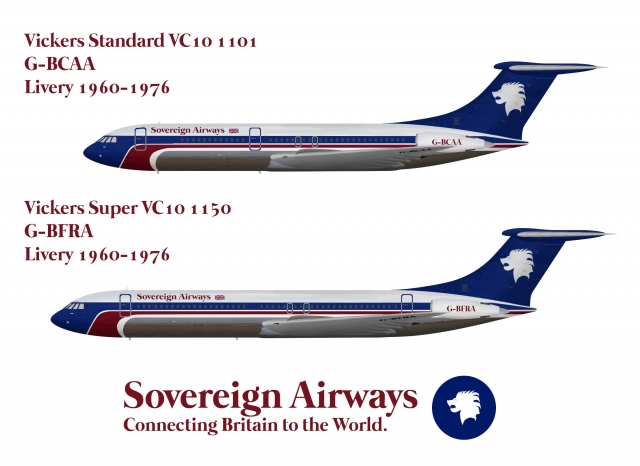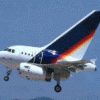Sovereign Airways Vickers VC10 Poster
- Owner: Rigel (View all images and albums)
- Uploaded: Aug 16 2020 06:19 AM
- Taken: 2020:08:16 16:05:14
- Views: 1,275
- Album ZYX - Brands By Rigel
Templates by POTKC. Logo and liveries by Rigel

In 1957, Sovereign Airways placed orders for 22 Boeing 707s. This caused an outrage in the UK aviation industry, as Sovereign Airways had always operated British aircraft, with the only non-British aircraft they operated being the Douglas DC-3 and Boeing 377 Stratocruiser. Therefore, the British Government encouraged Sovereign Airways to cancel the 707 order and buy British instead.
It just so happened at the time that Vickers was working on a new tanker aircraft for the RAF, known as the Vickers V-1000. Sovereign Airways showed great interest in the aircraft, and requested that a civilian version be created. Thus, the Vickers VC7 program was created, on the basis of the V-1000.
However, the V-1000 and VC7 didn't last. The program was constantly being delayed due to the delays with the engine in development for the aircraft, the Rolls-Royce Conway. Sovereign Airways also was slightly iffy on supporting another British aircraft development, especially after the problems encountered with the Bristol Britannia and De Havilland Comet. Thus, the VC7 program was cancelled, with the V-1000 following suit a few months later.
However, Sovereign Airways realised that the Boeing 707s they had ordered would be oversized and underpowered for the routes they were originally meant to operate on, which were Sovereign Airways' "Empire Connection" routes, to places such as Canada, India, Africa, and potentially Australia. These places all had relatively short runways, which the 707 couldn't access. So, Sovereign Airways was in need of an aircraft that could better reach these areas of the world.
Vickers responded to their request with the new aircraft development, the VC10. This aircraft had amazing performance, exactly what SV needed for the Empire Connection routes. So, despite competition from De Havilland and Handley Page, the VC10 was chosen to operate the routes. The initial order consisted of 20 VC10s. However, with passenger travel booming across the world, the standard 135-passenger VC10 was quite small. So, Sovereign Airways requested Vickers to develop a more capacious version, the result of which was the 3.9m longer Super VC10 1150, of which Sovereign Airways ordered 30.
Unfortunately, however, by the time the VC10 was ready to enter service, the airports the plane was supposed to serve had been upgraded, and were now capable of handling Boeing 707s. The 707-420 was also more efficient than the VC10 despite having the same engines, due to reduced weight, particularly at the tail. SV would eventually receive 13 Standard VC10s and 11 Super VC10s. The plane would never achieve its planned sales figures, which spelled the end for all-British jets to challenge the Americans.
Shown above is G-BCAA, Sovereign Airways' first Standard VC10 delivered to the airline in 1964, and G-BFRA, their first Super VC10, which entered service in 1965, wearing the airline's 1960 livery, unveiled on the 707-420 four years before the VC10 introduction. The VC10s would end up mainly flying transatlantic to the USA and Canada, but some also flew down to the Caribbean, and to other British territories such as India and Ghana. The final VC10 was retired from Sovereign Airways' fleet in 1982, alongside the 707-420 fleet.
Leave feedback! Any and all feedback helps (but preferably constructive).

 Sign In
Sign In Create Account
Create Account














